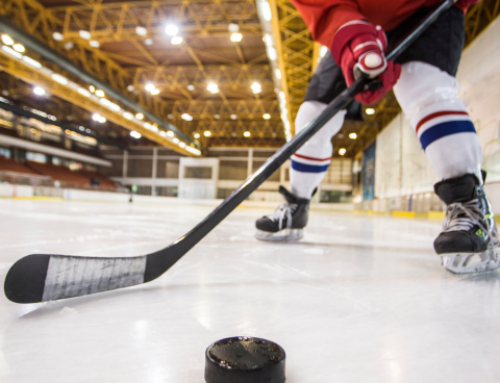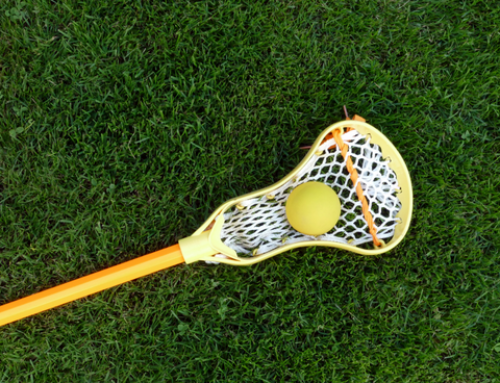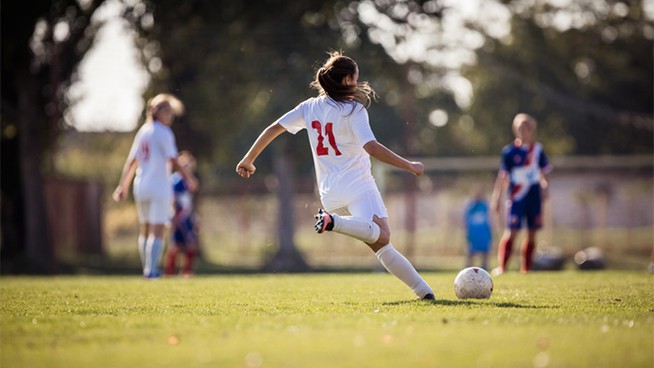5 Hockey Lower-Body Exercises That Improve Skating Speed
![]()
Hockey players often share a common weakness: Their skating stride is too shallow, which robs them of their speed.
There’s a fairly straightforward solution to this: Bringing your leg back under your center of mass will give you a more powerful stride.
Speed is influenced by stride length. But your leg is only so long, and you cannot push farther if your leg is not long enough. To improve stride length and power, start the stride closer to the midline of your body.
RELATED: 6 Essential Exercises to Improve Your Skating Speed
Most hockey players only extend their leg to outside hip level, which contributes to a short stride. They lack strength with their leg under their center of mass, which causes a shortened push.
This is where unilateral or single-leg work becomes really important to improve hockey speed.
Squatting or deadlifting on both legs—often performed with the legs just outside the hips—is important for creating general strength. Training on one leg reduces the base of support, and the working leg ends up closer to the center of mass.
RELATED: Perfect Your Arm Drive to Improve Your Hockey Skating Speed
1. Single-Leg Squats
[youtube video=”hu-Qwqpfd3w” /]This is one of my new favorites for developing strength with a narrow base for hockey. They train the athlete for lower-body strength and control.
The two variations I like best are standing on a box and squatting to a box. Squatting to a box or bench is a progression of the standing version.
This movement is best used as an accessory exercise; 3-4 sets of 6-8 reps will really make a difference on the ice.
2. Slideboard Reverse Lunge
[youtube video=”NBIZ6j9zht” /]This exercise trains strength under the center of mass, with an added benefit of activating the groin with the slideboard.
Hockey players are cursed with groin pulls and strains. Muscles strain when they are weak and/or short. The groin does not move through a huge range of motion, and it usually lacks strength compared to its opposite muscle group, the glutes.
Making up that strength imbalance can greatly improve speed. Shoot for the same sets and reps as above.
RELATED: This Drill Helps You Develop Elite Skating Speed and Power
3. Bulgarian/RFE Split Squat
[youtube video=”roEB8ew-5b” /]We could argue about whether it’s called a Bulgarian Squat or a Rear-Foot-Elevated Split Squat, but this movement is the easiest one to load. You can use heavy dumbbells or a barbell for a great amount of overload.
A lot of programs use this exercise to replace the squat pattern. This is for good reason, because you know if someone can split-squat several plates, they have real strength.
I like 3-5 sets of 4-6 reps on each leg.
4. Lateral Lunge
[youtube video=”c3kWX_aAYZY” /]This is a frontal plane movement. Since the hockey stride hits the frontal plane, hockey players would be smart to train that plane with their strength work.
This will help improve strength and stability to promote greater speed on the ice.
5. Bowler Squat
[youtube video=”HXmUPaeverM” /]I really like the Bowler Squat because of the hip range of motion required. It also lights up your glutes really well.
The Bowler Squat is almost a combination of a Single-Leg Squat/Deadlift, and an RDL. Delivering a big bang for your buck, it also improves hip mobility for hockey players.
[cf]skyword_tracking_tag[/cf]RECOMMENDED FOR YOU
5 Hockey Lower-Body Exercises That Improve Skating Speed
![]()
Hockey players often share a common weakness: Their skating stride is too shallow, which robs them of their speed.
There’s a fairly straightforward solution to this: Bringing your leg back under your center of mass will give you a more powerful stride.
Speed is influenced by stride length. But your leg is only so long, and you cannot push farther if your leg is not long enough. To improve stride length and power, start the stride closer to the midline of your body.
RELATED: 6 Essential Exercises to Improve Your Skating Speed
Most hockey players only extend their leg to outside hip level, which contributes to a short stride. They lack strength with their leg under their center of mass, which causes a shortened push.
This is where unilateral or single-leg work becomes really important to improve hockey speed.
Squatting or deadlifting on both legs—often performed with the legs just outside the hips—is important for creating general strength. Training on one leg reduces the base of support, and the working leg ends up closer to the center of mass.
RELATED: Perfect Your Arm Drive to Improve Your Hockey Skating Speed
1. Single-Leg Squats
[youtube video=”hu-Qwqpfd3w” /]This is one of my new favorites for developing strength with a narrow base for hockey. They train the athlete for lower-body strength and control.
The two variations I like best are standing on a box and squatting to a box. Squatting to a box or bench is a progression of the standing version.
This movement is best used as an accessory exercise; 3-4 sets of 6-8 reps will really make a difference on the ice.
2. Slideboard Reverse Lunge
[youtube video=”NBIZ6j9zht” /]This exercise trains strength under the center of mass, with an added benefit of activating the groin with the slideboard.
Hockey players are cursed with groin pulls and strains. Muscles strain when they are weak and/or short. The groin does not move through a huge range of motion, and it usually lacks strength compared to its opposite muscle group, the glutes.
Making up that strength imbalance can greatly improve speed. Shoot for the same sets and reps as above.
RELATED: This Drill Helps You Develop Elite Skating Speed and Power
3. Bulgarian/RFE Split Squat
[youtube video=”roEB8ew-5b” /]We could argue about whether it’s called a Bulgarian Squat or a Rear-Foot-Elevated Split Squat, but this movement is the easiest one to load. You can use heavy dumbbells or a barbell for a great amount of overload.
A lot of programs use this exercise to replace the squat pattern. This is for good reason, because you know if someone can split-squat several plates, they have real strength.
I like 3-5 sets of 4-6 reps on each leg.
4. Lateral Lunge
[youtube video=”c3kWX_aAYZY” /]This is a frontal plane movement. Since the hockey stride hits the frontal plane, hockey players would be smart to train that plane with their strength work.
This will help improve strength and stability to promote greater speed on the ice.
5. Bowler Squat
[youtube video=”HXmUPaeverM” /]I really like the Bowler Squat because of the hip range of motion required. It also lights up your glutes really well.
The Bowler Squat is almost a combination of a Single-Leg Squat/Deadlift, and an RDL. Delivering a big bang for your buck, it also improves hip mobility for hockey players.
[cf]skyword_tracking_tag[/cf]









